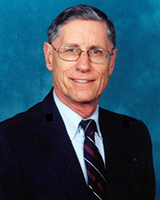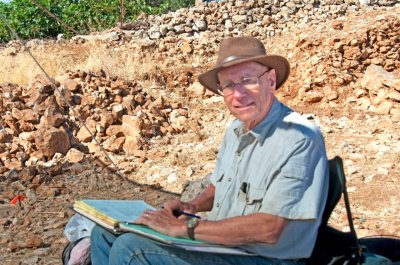
Welcome to Discussions with the Diggers, a new type of blog I’m introducing at Bible Archaeology Report. I’m planning to regularly interview archaeologists to learn more about their work and how the excavations they’ve been a part of illuminate Scripture.

My first interview is with Dr. Bryant Wood from the Associates for Biblical Research (ABR). Dr. Wood was the Director of the Khirbet el-Maqatir excavations in Israel, from 1994 to 2013; and the Ceramic Typologist for the Khirbet el-Maqatir excavation from 2014 to 2016. He is currently ABR’s Director of Research and Consulting Editor with of their magazine Bible and Spade. Dr. Wood is a specialist in Canaanite pottery of the Late Bronze Age and is author of The Sociology of Pottery in Ancient Palestine: The Ceramic Industry and the Diffusion of Ceramic Style in the Bronze and Iron Ages (1990).
BIBLE ARCHAEOLOGY REPORT: Welcome Dr. Wood! Before we talk about your work as an archaeologist, how did you become interested in archaeology?
DR. BRYANT WOOD: It all started when my mother-in-law gave me the book The Bible as History by Werner Keller as a Christmas present in 1958. As a young mechanical engineer with a scientific background, it fascinated me that things relating to the Bible were dug up out of the ground. The book got me started on a path of studying archaeological discoveries that relate to the Bible.
BIBLE ARCHAEOLOGY REPORT: What digs have you been a part of?

DR. BRYANT WOOD: My first trip to the Middle East was in 1978 when I was a graduate student at the University of Toronto. I was asked to be part of team that surveyed three dam reservoir areas in northern Jordan that were to be flooded when the three dams were completed. Following that, I participated in the excavation of Tell el-Maskhuta in the eastern Nile delta in 1979, 1981 and 1983. In 1981 I participated in the excavation of Haruvit in the northern Sinai and in 1983 I was a member of the Wadi Tumilat survey in the eastern Nile delta. I excavated at Kh, Nisya in 1985, 1987, 1990, 1991, 1993, and 1994, and Kh. el-Maqatir 1995–2000 and 2009–2016.
BIBLE ARCHAEOLOGY REPORT: Can you describe for us the discovery Joshua’s Ai at Khirbet el-Maqatir?

DR. BRYANT WOOD: ABR was founded for the purpose of finding the correct site for Ai, since the accepted site, et-Tell, does not fit the Biblical description, resulting in scholars doubting the validity of the Biblical account. David Livingston, the founder of ABR in 1969, believed that Ai was located at Kh. Nisya 3.7 km SW of et-Tell. Despite 18 seasons of excavation, no architecture from the LB I period was found, and only 39 sherds were identified as possibly LB I, 15 of which I personally excavated in 1985. I began looking for other candidates in the area and discovered Kh. el-Maqatir 1 km W of et-Tell in a survey report published in 1993. Visits to the site in 1993 and 1994 convinced me that it was a good candidate, so I applied for an excavation permit and began digging with a team of 12 in 1995. We found evidence for a gate that first season, so we knew we were on the right track. By comparison with Nisya, in 14 seasons we excavated 323 diagnostic refired LB IB sherds from the time of destruction of the fortress in 1406 BC, not to mention many hundreds, if not thousands (I have not tried to count them!), of diagnostic sherds from the construction and occupation phases, ca. 1650–1406 BC.

BIBLE ARCHAEOLOGY REPORT: What is the importance of this discovery?
DR. BRYANT WOOD: The previously accepted site for Ai, et-Tell, was not occupied at the time of the Conquest. This has led scholars to conclude that the Biblical account in Joshua 7–8 is fictional, since archaeologists are “certain” that et-Tell was Ai. To find the correct location of Ai will remove a major argument against the historicity of the Old Testament.
BIBLE ARCHAEOLOGY REPORT: What are you currently working on?
DR. BRYANT WOOD: I am working on the Bronze Age fortress portion of vol. 1 of our final dig report. The second half of vol. 1 is the Iron Age period, being written by Boyd Seevers, Professor of Old Testament Studies, University of Northwestern—St. Paul.

In 2019, Dr. Wood was honored in the Winter issue of Bible and Spade, which was subtitled, “Let The Stones Cry Out: The Life and Legacy of Dr. Bryant Wood.” You can order a copy of Bible and Spade HERE.
You can also find many articles written by Dr. Wood at ABR’s website – BibleArchaeology.org. Here are a few that I highly recommend:
- The Search for Joshua’s Ai
- Did the Israelites Conquer Jericho: A New Look at the Archaeological Evidence
- The Rise and Fall of the 13th Century Exodus-Conquest Theory
- Hittites and Hethites: A Proposed Solution To An Etymological Conundrum
I’d like to thank Dr. Bryant Wood for taking time to answer my questions and for his legacy as an archaeologist known for his quality work in the field as well as his commitment to the historical reliability of Scripture.

Disclosure: Both Dr. Wood and I are staff members of the Associates for Biblical Research (BibleArchaeology.org).
Disclaimer: I allow each archaeologist to answer in his or her own words and may or may not agree with his or her interpretation of their work.
